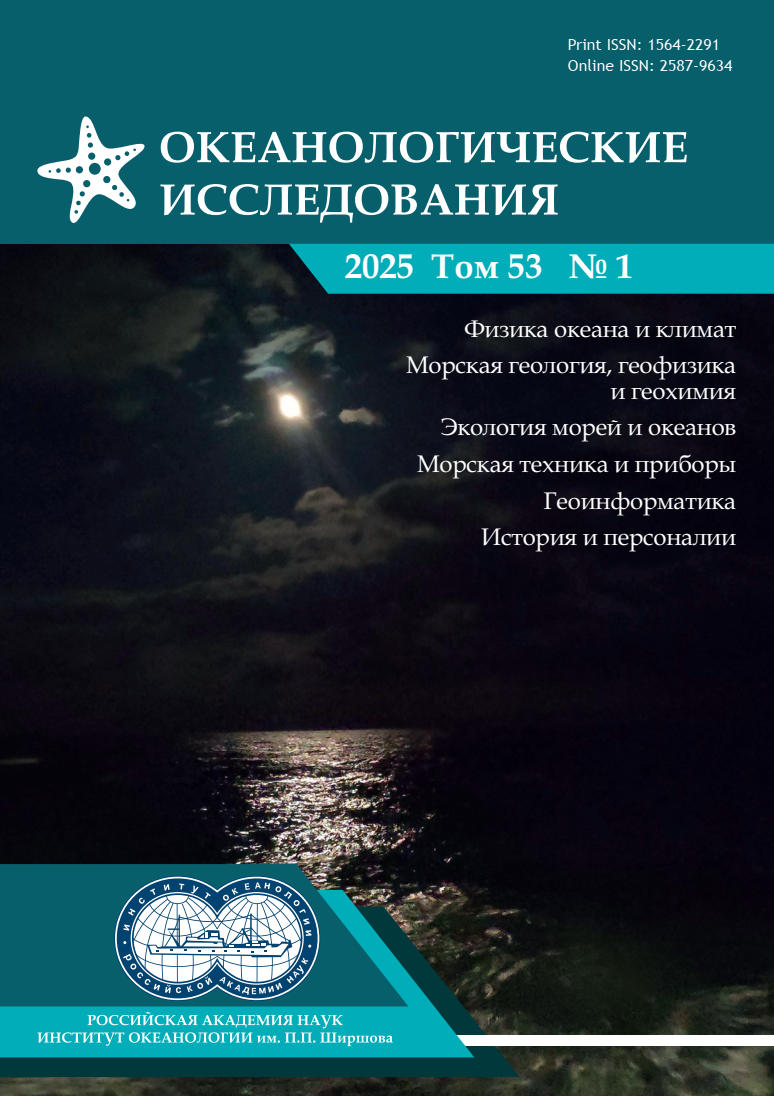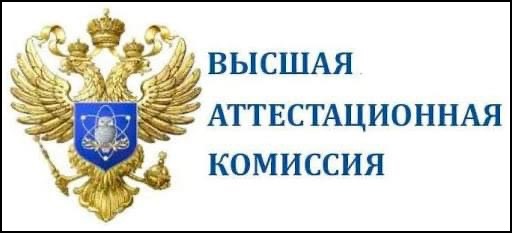СЕЗОННАЯ ДИНАМИКА ПОСЕЛЕНИЙ ДВУСТВОРЧАТЫХ МОЛЛЮСКОВ LUCINELLA DIVARICATA И GOULDIA MINIMA НА СЕВЕРО-ВОСТОЧНОМ ШЕЛЬФЕ ЧЕРНОГО МОРЯ
Аннотация
В работе собраны и проанализированы данные по вертикальному распределению, сезонной динамике обилия, размерному составу и срокам размножения двух массовых видов двустворчатых моллюсков – Lucinella divaricata и Gouldia minima. Район исследования – шельф северо-восточного сектора Черного моря близ пос. Дивноморское. Материал собран весной, летом, осенью и зимой 2023 г. и весной и летом 2024 г. Наиболее многочисленные поселения L. divaricata отмечены на глубине 15 м на чистых песках с содержанием ила менее 10 % и органического углерода менее 0.3 %. Массовые поселения G. minima выявлены на глубине 30–40 м на заиленной ракуше с содержанием ила 40–60 % и органического углерода 1–1.5 %. Прирост длины раковины L. divaricata достигал 3 мм в год, G. minima – более 6 мм в год. Созревание гонад у L. divaricata в 2023 г. отмечалось в летний сезон, а G. minima – в позднеосенний. Наибольшей биомассы и численности поселения L. divaricata достигали в летний период, но летом 2024 г. эти показатели были в среднем в 1.5–2.0 раза ниже, чем летом 2023 г. Численность G. minima снижалась в 2023 г. с апреля по сентябрь, а в 2024 г. она была в 2 раза ниже, чем в 2023 г. Наибольших биомасс G. minima достигали в весенний и летний периоды, а в сентябре ее биомасса была наиболее низкой. В 2024 г. у обоих видов было отмечено увеличение средних размеров молоди и более пологие пики на размерно-частотных гистограммах, задержка развития гонад и снижение обилия молодых особей в поселениях по сравнению с 2023 г. Обсуждаются причины слабого пополнения поселений обоих видов молодью в первой половине 2024 г. и возможная продолжительность жизни особей в поселениях.
Литература
- Дулов В. А., Юровская М. В., Фомин В. В., Шокуров М. В., Юровский Ю. Ю., Барабанов В. С., Гармашов А. В. Экстремальный черноморский шторм в ноябре 2023 года // Морской гидрофизический журнал. 2024. T. 40. № 2 (236). C. 325–347.
- Заика В. Е., Валовая Н. А., Повчун А. С., Ревков Н. К. Митилиды Черного моря. Киев: Наукова думка, 1990. 205 с.
- Захваткина К. А. Личинки двустворчатых моллюсков Севастопольского района Черного моря // Труды Севастопольской биологической станции. 1959. T. 11. C. 108–152.
- Захваткина К. А. Фенология личинок двустворчатых моллюсков Севастопольской бухты // Труды Севастопольской биологической станции. 1963. T. 16. C. 173–175.
- Иванов В. А., Белокопытов В. Н. Океанография Черного моря. Севастополь: Морской гидрофизический институт НАН Украины, 2011. 212 с.
- Киселева М. И. Особенности размерного состава популяций двустворчатых моллюсков, обитающих в разных биотопах // Гидробиологический журнал. 1978. T. 14. № 1. C. 54–58.
- Киселева М. И. Бентос рыхлых грунтов Черного моря. Киев: Наукова Думка, 1981. 168 с.
- Колючкина Г. А., Семин В. Л., Григоренко К. С., Басин A. B., Любимов И. В. Роль абиотических факторов в вертикальном распределении макрозообентоса северо-восточного побережья Черного моря // Зоологический журнал. 2020. T. 99. № 7. C. 784–800. https://doi.org/10.31857/S0044513420070053.
- Носов Н. А. Введение в теорию цунами. Москва: Янус-К, 2019. 170 с.
- Ревков Н. К., Тимофеев В. А., Лисицкая Е. В. Состав и сезонная динамика макрозообентоса локального биотического комплекса Chamelea gallina (западный Крым, Черное море) // Экосистемы. 2014. № 11 (30). C. 247–259.
- Санамян К. Э., Санамян Н. П. Метод «изопропанол–минеральное масло» в гистологии // Сохранение биоразнообразия Камчатки и прилегающих морей: материалы ХIII международной научной конференции. Петропавловск-Камчатский: Камчатпресс, 2012. C. 155–159.
- Скарлато О. А., Старобогатов Я. И. Класс двустворчатые моллюски – Bivalvia // Определитель фауны Черного и Азовского морей / Ред. Мордухай-Болтовской Ф. Д. Киев: Наукова думка, 1971. C. 178–249.
- Федоров А. В., Федорова П. А., Хоменко С. А., Ключанцева А. П. Динамика фитопланктона в Голубой бухте (г. Геленджик) в 2024 г. // Экология гидросферы. 2025. C. 1–16. [в печати].
- Akaike H. A new look at the statistical model identification // IEEE transactions on automatic control. 1974. Vol. 19. No. 6. P. 716–723.
- Ansell A. D. The functional morphology of the British species of Veneracea (Eulamellibranchia) // Journal of the Marine Biological Association of the United Kingdom. 1961. Vol. 41. No. 2. P. 489–517.
- Barnes P. A. G. Eco-physiology of the endosymbiont-bearing lucinid bivalve, Codakia orbiculata; University of Plymouth. Plymouth, 1993. 411 p.
- Dempster A. P., Laird N. M., Rubin D. B. Maximum likelihood from incomplete data via the EM algorithm // Journal of the royal statistical society: series B (methodological). 1977. Vol. 39. No. 1. P. 1–22.
- Funder S., Demidov I., Yelovicheva Y. Hydrography and mollusc faunas of the Baltic and the White Sea–North Sea seaway in the Eemian // Palaeogeography, Palaeoclimatology, Palaeoecology. 2002. Vol. 184. No. 3–4. P. 275–304. https://doi.org/10.1016/S0031-0182(02)00256-0.
- Gaudin F., Desroy N., Dubois S. F., Broudin P., Cabioch L., Fournier J., Gentil F., Grall J., Houbin P., Le Mao P. Marine sublittoral benthos fails to track temperature in response to climate change in a biogeographical transition zone // ICES Journal of Marine Science. 2018. Vol. 75. No. 6. P. 1894–1907. https://doi.org/10.1093/icesjms/fsy095.
- Gros O., Frenkiel L., Moueza M. Embryonic, larval, and post-larval development in the symbiotic clam Codakia orbicularis (Bivalvia: Lucinidae) // Invertebrate Biology. 1997. P. 86–101.
- Herry A., Le Pennec M. Endosymbiotic bacteria in the gills of the littoral bivalve molluscs Thyasira flexuosa (Thyasiridae) and Lucinella divaricata (Lucinidae) // Symbiosis. 1987. Vol. 4. P. 25–36.
- Le Pennec M., Diouris M., Herry A. Endocytosis and lysis of bacteria in gill epithelium of Bathymodiolus thermophilus, Thyasira flexuosa and Lucinella divaricata (Bivalve, Molluscs) // J. Shellfish Res. 1988. Vol. 7. P. 483–489.
- Poppe G. T., Goto Y. Scaphopoda, Bivalvia, Cephalopoda. European Seashells. Wiesbaden: Christa Hemmen Verlag, 1993. European Seashells. 221 p.
- Şahin P., Emiral H., Okumus I., Gözler A., Kalayci F., Hacimurtezaoglu N. The Benthic Exotic Species of the Black Sea: Blood Cockle (Anadara inaequivalvis, Bruguiere, 1789: Bivalve) and Rapa Whelk (Rapana thomasiana, Crosse, 1861: Mollusc) // Journal of animal and veterinary advances. 2009. Vol. 8. No. 2.
- Sardá R., Pinedo S., Martin D. Seasonal dynamics of macroinfaunal key species inhabiting shallow soft-bottoms in the Bay of Blanes (NW Mediterranean) // Acta Oecologica. 1999. Vol. 20. No. 4. P. 315–326. https://doi.org/10.1016/S1146-609X(99)00135-6.
- Sea temperature // https://sea-temperature-ru.com/russian-federation/.(дата обращения: 13.12.2024).
- Taylor J. D., Glover E. A. Chemosymbiotic bivalves // The vent and seep biota: aspects from microbes to ecosystems. 2010. P. 107–135. https://doi.org/10.1007/978-90-481-9572-5_5.
- Wentworth P. K. A scale of grade and class terms for clastic sediments // The journal of geology. 1922. Vol. 30. No. 5. P. 377–392.
Передача авторских прав происходит на основании лицензионного договора между Автором и Федеральным государственным бюджетным учреждением науки Институт океанологии им. П.П. Ширшова Российской академии наук (ИО РАН)













